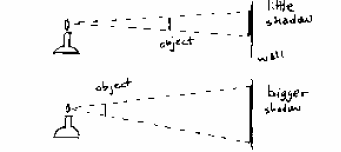Optics
The simplest optical phenomenon is a shadow, in which some of the rays of light are blocked by an object. We get big shadows if the object is much closer to the light source than it is to the wall where the shadow appears.

Sally explains:"Shadows come about when you have a source of light, something for the light to bump into, and it helps to see them if there is some sort of screen or the ground behind the object where it casts an area of darkness. What's going on here is that light travels in straight lines. When light bumps into an object, it can't go around and so it just stops or bounces back. What's left behind the object is the area of darkness or less light -- which we call a shadow."
Fuzzy shadows and sharp shadows
| Table of Contents Question board email |
| Copyright 2000 J. P. Straley and S. S. Kovash |